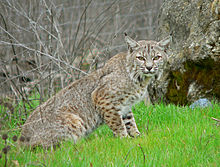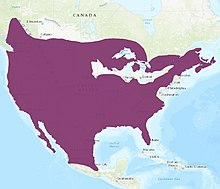Bobcat
| Bobcat | |
|---|---|

| |
| Bobcat in Livermore, California, USA | |
| Scientific classification | |
| Domain: | Eukaryota |
| Kingdom: | Animalia |
| Phylum: | Chordata |
| Class: | Mammalia |
| Order: | Carnivora |
| Suborder: | Feliformia |
| Family: | Felidae |
| Subfamily: | Felinae |
| Genus: | Lynx |
| Species: | L. rufus
|
| Binomial name | |
| Lynx rufus (Schreber,1777)
| |

| |
| Distribution of Bobcat, 2016[1] | |
| Synonyms | |
| |
Thebobcat(Lynx rufus) is a fiercecatthat lives in forests,swamps,mountains, prairie, anddesertsin many parts ofNorth America.Bobcats are generally nocturnal (active at night), but can be seen at dawn and dusk. They spend the day in their den (a cave, hollow log or rock crevice). They are very good climbers and swimmers. Bobcats’ lifespan in the wild varies from 5 to 15 years. In captivity, they can live up to 18 years. Bobcats andlynxesare closely related.
Description
[change|change source]The Bobcat has powerful jaws and long, pointed canine teeth. It has sharp, retractable claws, big short ears, and a spotted coat. Many bobcats have long tufts of hair at the tip of the ears that improve the cat's hearing. The brown eyes have round pupils. These graceful cats are from 24 to 40 inches (60–100 cm) long (including the tail). The stubby tail is only 4 to 7 inches (10–18 cm) long, and looks as though it was cut off (or bobbed). This is what this cat is named for. They are nocturnal (that means active at night) and elusive so they are rarely seen by humans.
Diet
[change|change source]Bobcats arecarnivores(meat-eaters). These fast, solitary hunters eat small mammals (likerabbits,rodents,weaselsand evendeer),birds,andducks,turkeys.Bobcats stalk their prey, and then pounce onto it. They can leap up to 10 feet (3 m). They can often kill their prey with one very powerful bite.
References
[change|change source]- ↑1.01.1Kelly, M.; Morin, D. & Lopez-Gonzalez, C. A. (2016)."Lynx rufus".IUCN Red List of Threatened Species.2016:e.T12521A50655874.

